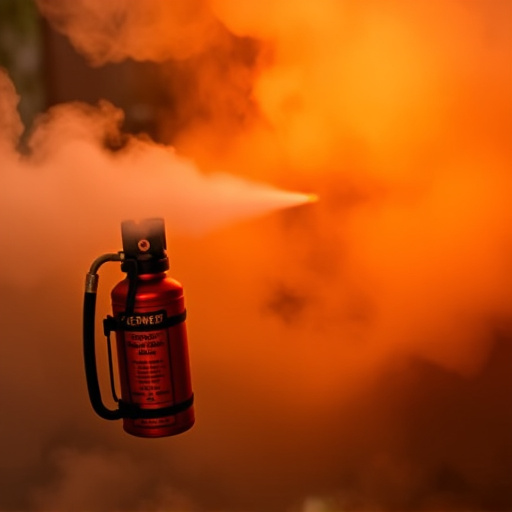Wildfire pepper spray foggers, powered by capsaicin and other irritants, offer crucial personal protection in high-risk scenarios like wildfires and law enforcement operations. These devices create a dense fog to deter animals, blind attackers temporarily, and provide escape time. Essential for outdoor adventurers, emergency responders, and wildfire-prone areas, they require proper usage, training, and safety protocols to ensure effectiveness and minimize health risks. Future advancements aim to improve these life-saving tools through safer formulations and targeted delivery systems.
In today’s world, personal protection devices (PPDs) play a crucial role in safeguarding individuals from various hazards. One innovative application of chemical irritants, such as those found in wildfire pepper spray foggers, has emerged as a powerful tool in personal safety gear. This article explores the strategic use of chemical irritants in PPDs, focusing on case studies like the wildfire pepper spray fogger. We delve into the benefits, considerations, and future innovations that enhance their effectiveness while ensuring user safety.
- Understanding Chemical Irritants: Their Role in Personal Protection Devices
- Wildfire Pepper Spray Fogger: A Case Study of Chemical Irritant Usage
- Benefits and Considerations for Using Chemical Irritants in Personal Safety Gear
- Safety Protocols and Future Innovations in Chemical Irritant Technology
Understanding Chemical Irritants: Their Role in Personal Protection Devices
Chemical irritants play a pivotal role in personal protection devices, especially in high-risk scenarios like wildfires or law enforcement operations involving wildfire pepper spray foggers. These substances are designed to disrupt an individual’s senses and provide critical moments of safety when facing dangerous situations. By causing temporary but intense irritation, they enable people to escape, evade, or defend themselves effectively.
In the context of wildfires, chemical irritants like capsaicin, often found in pepper spray, can quickly incapacitate or deter aggressors, allowing victims time to flee. The fogger mechanism disperses these irritants as a fine mist, ensuring broad coverage and maximum effectiveness. This strategic use of chemical irritants enhances personal protection, especially in chaotic and fast-paced environments where traditional methods might be less reliable.
Wildfire Pepper Spray Fogger: A Case Study of Chemical Irritant Usage
The wildfire pepper spray fogger is a compelling example of how chemical irritants can be harnessed for personal protection in extreme conditions. This innovative device has gained significant attention, especially in regions prone to wildfires. It uses a specialized formula that combines capsaicin, the primary active ingredient in chili peppers, with other components to create a potent yet controlled spray. When deployed, it creates a dense fog of irritants that can effectively disable or deter aggressive animals and even provide temporary blindness, giving users crucial seconds to escape hazardous situations.
This technology showcases the practical application of chemical irritants as a non-lethal force multiplier for personal safety. The wildfire pepper spray fogger’s design allows for rapid deployment, ensuring users can quickly respond to sudden threats. Its effectiveness has been tested in various simulations, proving its ability to disrupt and disorient potential attackers, making it an invaluable asset for outdoor enthusiasts, emergency responders, and individuals living in high-risk areas.
Benefits and Considerations for Using Chemical Irritants in Personal Safety Gear
Using chemical irritants, such as those found in wildfire pepper spray foggers, offers significant advantages for personal safety devices. These substances can act as powerful deterrents against potential threats, providing individuals with an effective means of self-defense and emergency escape. For instance, during wildland fires or other hazardous situations, a pepper spray fogger can enable quicker evacuation by temporarily incapacitating irritant pathways in the eyes and respiratory system, allowing users to navigate through thick smoke or hostile environments with reduced visibility.
Despite their benefits, there are important considerations regarding chemical irritants in personal safety gear. Safety and effectiveness depend on proper usage and training, as misapplication can lead to unwanted injuries or even harm. Additionally, environmental impact and potential health risks associated with certain chemicals must be carefully evaluated. Regulations and guidelines should be followed when choosing products like wildfire pepper spray foggers to ensure their components meet safety standards and are suitable for intended use cases.
Safety Protocols and Future Innovations in Chemical Irritant Technology
In the realm of personal protection devices, chemical irritants like wildfire pepper spray foggers play a pivotal role in safeguarding individuals against potential threats. Safety protocols are meticulously designed to ensure their effective and responsible use. These include strict guidelines on training and certification for users, proper storage and maintenance practices, and clear instructions on decontamination procedures following exposure. Regular testing and calibration of devices help guarantee their reliability in critical situations.
Future innovations in chemical irritant technology promise enhanced safety measures. Researchers are exploring more potent yet safer formulations, focusing on targeted delivery systems to minimize collateral damage. Advances in nanotechnology could lead to microscopic irritants that maintain potency while reducing environmental impact. Additionally, smart sensors integrated into personal protection devices may offer real-time monitoring of toxic gas levels, providing early warnings and adaptive protective responses. These developments underscore the continuous efforts to improve safety without compromising the effectiveness of chemical irritant-based personal protection devices.
The exploration of chemical irritants, as demonstrated by the case study of the wildfire pepper spray fogger, highlights their significant role in personal protection devices. These substances offer effective deterrents against various threats, enhancing safety measures in high-risk environments. While they provide numerous benefits, careful consideration is essential to address potential risks and ensure user well-being. Future innovations in chemical irritant technology should focus on developing safer, more targeted solutions while adhering to strict safety protocols. By continuing to research and optimize these compounds, personal protection devices can evolve to better safeguard individuals facing hazardous situations, such as wildfires.
